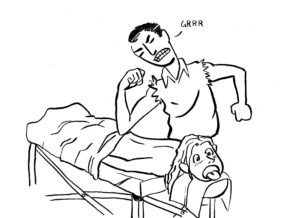Does the 0 to 10 Pain Scale Really Work?
Most MTs, PTs, and other health practitioners use the 0 to 10 pain scale with clients and patients. I use it all the time. I guide my clients by saying, “10 means take me to the emergency room. 0 means you don’t feel it at all.” I listen and, just as I instruct students in the Ray of Light Training CE classes, I look for other signs that may indicate more about their pain level.
Most of us realize that the 0 to 10 pain scale has its limitations. Everyone’s pain scale is different. Sometimes, therapists discount what the client says and use their (the therapist’s) pain scale instead of paying attention to what the client says. “This is good for you. I can’t loosen the muscles up if I use less pressure. You’ll thank me in the morning.”

That’s what some clients have told me they heard from therapists. They felt disrespected, hurt, and often bruised. No, they didn’t thank them in the morning. In fact, they never went back. Some didn’t go get bodywork again for years, fearing a similar experience. The opportunity for a therapist that gets such a “rebound client” is to show them what a good, professional session feels like. Often the client does indeed thank them in the morning.
Then there are those clients that are afraid that if they say the pain is higher on the scale, the therapist will back off, and they won’t get a good session. Or sometimes, they’re just too “macho” to admit that it hurts like crazy. Then there are those people that are so disconnected from their bodies that they have no idea how much it hurts.
That’s why you also want to check their hands to see if they’re clenched. And their face to see if their eyes are squeezed shut or their jaw is locked. And their legs and muscles in general to see if they’re in high-resistance mode.
There are lots of other reasons why the 0 to 10 pain scale may or may not be helpful. In medical circles, the patient’s response can determine what medications and dosages they get. It might also affect the level of physical therapy and exercise that’s recommended. Either way, it can determine how long or short their recovery is.

In her article on NPR’s Morning Edition, Words Matter When Talking About Pain With Your Doctor, Patti Neighmond dives into this topic. What she found in her research is very enlightening for us therapists. A study done at the University of Rochester suggests that asking more questions than just the pain scale number can be very beneficial. Questions like:
“Is your pain tolerable?”
“What specific words would you use to describe your pain?”
“Is it achy pain? Burning pain? Shooting pain?”
“How does this compare with pain you may have had in the past? Such as childbirth? Or passing kidney stones?”
“How long have you been experiencing this pain?”
“When do you feel the pain most? What time of day?”
“What daily activities or movements make the pain worse? Or better?”
“What types of medical or alternative treatment have you received for it? What treatments helped? Which didn’t?”
There are many things we can do to get a better sense of where the client is at with their pain, what types of techniques will help them the most, and how much pressure is best. The 0 to 10 pain scale isn’t going to go away. It’s still very helpful to get a quick read on their pain. But we want to be open and use whatever tools and strategies we have at our disposal to understand their condition and how our work is affecting them. Then, maybe they’ll thank you the next morning. 🙂

Check out the upcoming Ray of Light Training CE classes, where you learn an excellent toolbox of gentle and deep techniques to loosen tight muscles and fascia in the Direct-Indirect Technique and Cranial-Sacral Therapy trainings. Also, check out the Muscle Balancing and Joint Stabilization classes that help you and your clients to strengthen areas that are weak or not functioning at 100%. The main goal is to have healthy happy clients, a healthy happy you, and a healthy thriving practice.
I hope to see you soon.
Stay well,
John
